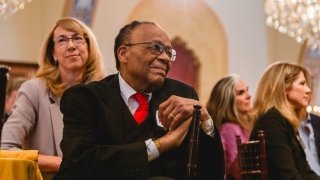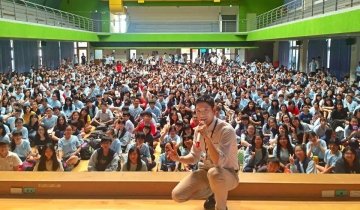After reading the Fall 2011 USC Viterbi Engineer, I immediately wrote Dean Yannis Yortsos and expressed my congratulations for such an outstanding issue. I found it to be exceptional in every respect. I was particularly impressed by its theme, “The Changing Face of Engineering,” and the editorial by Dean Yortsos in which he stated: “The new face of engineering is not that of ‘Dilbert’ in the cartoons. It is the face of bright women and men, spanning societal, racial and ethnic divides.” The commitments to diversity and inclusion reflected in the issue and in the dean’s remarks can be significant hallmarks for the Viterbi School of Engineering and are fully deserving of our most vigorous and sustained efforts to advance and preserve them.
America is a nation embroiled in a global contest for scientific and technological leadership. In today’s flat world, we must act quickly on a number of fronts to maintain a strong position of competitiveness in science and technology in order to ensure a future of prosperity and security. Failure to act will guarantee that preeminence in innovation and entrepreneurship will reside in the hands of those nations that are most adept at developing and retaining talent. As Shirley Ann Jackson, president of Rensselaer Polytechnic Institute and former head of the Nuclear Regulatory Commission, said, “If we fail to act, the looming gap in the U.S. science and engineering workforce is a quiet crisis that will grow in intensity and quickly undermine the ability of our nation to continue as the preeminent leader in science and engineering.”
Given the demographic changes occurring in America, the deficiencies in many of our elementary and secondary schools, the tremendous progress in science and technology occurring in developing countries, and tightening immigration policies, we can no longer depend upon an endless supply of foreign talent, nor continue to afford the historic underrepresentation of women and minorities in the STEM disciplines. Confronting the Grand Challenges of Engineering will require that we improve opportunities for all Americans to receive rigorous and high quality educations in science and engineering. In short, the engineering profession must shed itself of the myopia that has limited its ability to benefit from the remarkable diversity of America. As Dean Yortsos stated in the concluding paragraph of his editorial, “ . . . the realization is urgently emerging of the need to engage all of our talent pool.”
Diversity is not an issue that was on the radar screen of the engineering profession in America until the latter decades of the 20th Century. It was not until 1974 that an industry-inspired national program was initiated to increase the number of underrepresented minority baccalaureate graduates. In that year, the proportion of African Americans, Latinos and American Indians reached one percent of the cohort of approximately 44,000 B.S. engineering graduates. The number of women engineering graduates was similarly miniscule. While it is true that progress has been made since that time, especially with the presence of women, the representation of members of these minority groups among engineering students as well as practitioners still lags far behind their presence in the population. It is important, though dismaying, to note that industry and government have done a better job of diversifying their senior technical and management-level engineering positions than have our research universities with their engineering faculties.
Former NAE president Bill Wulf noted that: “Sans diversity, we limit the set of life experiences applied, and as a result, we pay an opportunity cost—a cost in products not built, in designs not considered, in constraints not understood, in solutions not offered, in processes not invented.” He said that members of a diverse group each experience life differently and that these differences in experience constitute the “gene pool from which creativity springs.” And in the very same vein, his successor as NAE president, Chuck Vest, has said, “A diverse technical workforce . . . is more likely to conceive, design and develop products, processes, and systems that perform well in the marketplace.”
Dean Yortsos stated it elegantly and well when he wrote “. . . innovation flourishes – it empowers engineering when diverse ideas and disruptive concepts spring about from a wide spectrum of talented hearts and minds. In this view, therefore, diversity is not a political slogan it is an essential ingredient.” In his most recent State of the School Address, he reminded us that we need to develop talent in all its various forms in order to facilitate “free, diverse, unencumbered discourse.”
It has long been recognized that the different life experiences and frames of reference that result from an amalgam of diverse individuals reflecting a broad range of social, cultural, and experiential backgrounds leads to the creativity needed to make innovative scientific and technological breakthroughs. The Italian Renaissance is a perfect historical example. The coming together of sculptors, poets, artists, scientists, philosophers, financiers and many other talented and creative individuals spawned that exciting period of history by descending upon Florence, finding each other, learning from each other, and breaking down the barriers between disciplines and cultures.
We are in the midst of a renaissance in engineering in which the fences between aerospace, biomedical, chemical, civil, electrical, industrial and mechanical engineering as well as the geophysical, material and all the natural and physical sciences are being felled, where biotechnology, information technology, nanotechnology and the neurosciences, to name a few, offer unlimited opportunities to improve the lives of people everywhere. It is a time when we can bring to bear the knowledge and resources of all of our disciplines as well as the arts, the humanities and the social sciences to solve the problems of the world and to create a better future for the generations that follow.
Big scientific and technical problems like renewable energy, climate change and infrastructure replacement cannot be solved by math and science and engineering practice alone. They require that engineering students are provided more than just a rigorous technical education. They require an appreciation for societal values, ethics and cultural mores. They require an understanding of the importance of these features in our research, our analyses, our designs and our deliverables. They require that students have more than just a cursory exposure to the liberal arts, the humanities and the social sciences. They require us to do more than simply provide students with the best math, science and engineering curricula, laboratories and instrumentation. They require us to re-examine what and how we teach them as well as re-thinking our expectations for them and for ourselves as their mentors and teachers.
I take much satisfaction in the recognition that academic engineering programs throughout America are seriously examining what and how we teach undergraduates. I have long felt that in order for our engineering students to contribute and prosper in the future that they need exposure to the languages and cultures of Asia and Europe and an appreciation for both Bach and biology, both Carlyle and calculus, both Dickinson and differential equations, both Giovanni and geometry, both Isaiah and isotopes, both Keynes and kinetics, both Mandarin and math, both Milton and molecules, both Picasso and picofarads, both Socrates and software, both Tennyson and tensors and, even, Al Jarreau as well as algebra. And while, admittedly, this prescribed curriculum is exaggerated for effect, it is intended to illustrate that our students need a much different learning experience than the one that has been provided by engineering programs for many years. It is, in my opinion, the nature of the broad education that this nation’s engineers must receive in order to be effective and productive contributors in the world of innovation and entrepreneurship we have entered—a diverse, multicultural, interdependent global society.
In their 2000 book, “Digital Divide,” David Bolt and Ray Crawford wrote, “Ideas, innovation, and advances that help all of society know no specific language or skin color. What a true embodiment of diversity means is that all segments of our society have the ability to share points of view, to discuss differences, to agree to be in accord or disagree, to develop a tolerance for ideas and influences different from our own, and to celebrate both our differences and our similarities.”
With this in mind, I urge that all of us, as members of the Viterbi School of Engineering, accept the challenge implicit in Dean Yortsos’ editorial to not only provide our students with a world-class engineering education but also provide leadership in guiding the discipline of engineering toward becoming a more diverse, pluralistic and inclusive profession. This must be done in full recognition of the reality that ingenuity, innovation and entrepreneurship are not functions of ethnicity, gender, language, physical ability, race, religion, sexual orientation or skin color and by so doing ensure that none of these features is allowed to serve as a barrier to opportunity.
— John Brooks Slaughter is a professor of education and engineering with a joint appointment at the USC Rossier School of Education and the USC Viterbi School of Engineering. He is the former president of Occidental College, former chancellor of the University of Maryland, as well as the first African-American to head the National Science Foundation.
> This article was originally published on the USC Viterbi School of Engineering. View the Viterbi site




